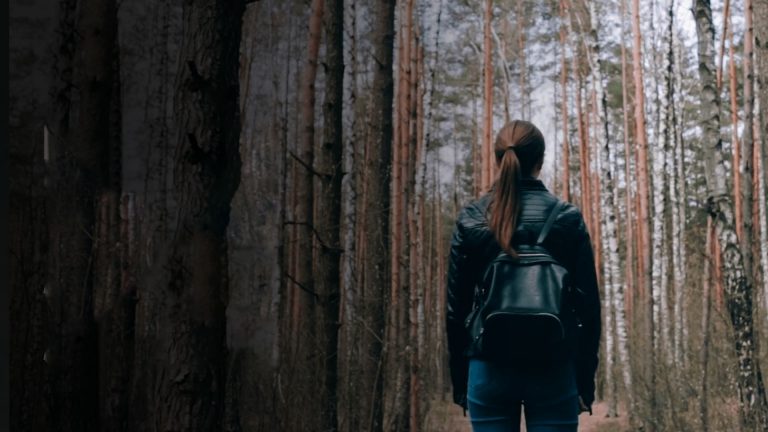Scroll down to watch the video
Wandering off the hiking trail seemed like a great way to get in touch with Mother Nature, but now every part of the forest is starting to look the same, and you’re not sure which direction you came from. You try to get your bearings by checking your phone, but the battery’s dead.
So what do you do now? You’re lost, and completely off the grid. It’s very easy to get lost in a forest.
Everything looks the same, so it’s hard to keep track of visual landmarks. And it’s nearly impossible to see any distant destinations beyond the trees.
So instead of focusing on finding your way out of the forest, you’re probably better off figuring out how to survive until someone finds you. How could we make a fire without a lighter or matches? Would we be better off eating plants or bugs? And how could we use pine needles to help us get rescued?

Step 1: Find Fresh Water
If you’re going to last out here for a long period of time, you’ll need to stay hydrated. Keep an eye out for animals, animal tracks, green foliage, mosquitoes, and flies, as they’re all good signs that water is nearby. In the forest, you are most likely to find a creek, stream, or pond.
Another way to stay hydrated is to save rainwater. If you have anything that will hold water, leave it out to collect rain or dew. If you don’t have any containers, use a tarp or a poncho, if you have them.
Hang them by tying the corners to trees, 3-4 feet (0.91 -1.22 meters) off the ground. Put a small rock in the middle of the material to make a kind of bowl to collect the water.

Step 2: Build A Shelter
The canopy of the trees above will provide decent shelter from the Sun, but if you’re going to be stuck here for a long time, you’re going to want something better. The easiest, most effective way to protect yourself from the elements would be to build a lean-to shelter.
To do this, you’ll need to find a large branch and lean one end against a tree. Then place smaller branches at 45-degree angles along the length of the large branch, and cover the entire structure with leaves and foliage.
Step 3: Find Food.
All that shelter building is bound to build up your appetite, so you need to start looking for something to eat. Plants would seem like the easiest bet, but you have to be careful, because a lot of them are poisonous.
Some characteristics of posionous plants to watch out for include white or yellow berries, thorns, mushrooms, and umbrella-shaped flowers. So unless you have a guidebook on which plants are edible, it’s best to play it safe and not eat any at all.

Instead, you can flip over logs to find easy-to-catch protein-filled insects. You can safely eat worms, ants, and grasshoppers, but avoid spiders, ticks, and flies.
And just to be safe, you should probably cook any insects before you eat them. But you can’t do that without heat.
Step 4: Make a Fire.
If you have a lighter or matches on you, then this shouldn’t be too hard. Start collecting everything you’re going to burn. Dry leaves or tree bark are easy to burn, so light them first.
Build a little teepee with the tinder and kindling. Tinder will be the first thing that catches a spark. It then transfers the spark to the kindling, and starts a flame.
But if you don’t have a lighter, you’ll need to get a little more creative. Make a fire plow to ignite the fire, by scraping a small groove into the middle of a flat piece of wood. Create friction by quickly plowing up and down the groove with a small twig, until it produces an ember.
Step 5: Get Rescued
Yes, this is easier said than done, but you’ve got to be proactive about it. Stay where you are. That way rescuers, will find you much more easily than if you hike around.
If you have a mirror, or some aluminum foil, you can use it to reflect light to planes or other people to help them find you. Another option would be to make smoke signals with your fire.
Green leaves and pine needles create a lot of smoke, so use those. Using a branch with leaves on it, cover the fire for 3-4 seconds to trap the smoke, then remove it. Keep doing that so it creates smoke clouds.
When you do finally get rescued, you’re going to have some time to think about how all this could’ve been avoided.
Next time, don’t wander off the guided trail. Research the area you’re going to be exploring beforehand, and bring along some supplies in case you do still get disoriented.
In some areas, you might even want to prepare yourself to defend against predators. But don’t worry, we’ve got just the video to help you come out on top.
Sources
- “Forest Survival Techniques You Should Know”. 2020. Backpacker.
- “How To Survive In The Woods”. 2020. Wikihow.
- “10 Reasons People Get Lost In The Wild”. 2020. Outdoor Life.
- “How people get lost in the woods and what to do if it happens to you”. 2020. Treehugger.
- “Why Humans Get Lost”. Ghose, Tia. 2013. livescience.com.
- “10 Step Survival Guide For Getting Lost In The Forest | Tourism On The Edge”. 2013. Tourism On The Edge.
- “12 Edible Bugs That Could Help You Survive” 2020. backpacker.com.


















